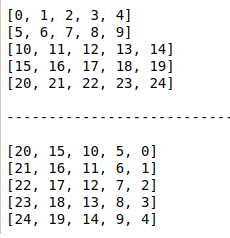旋转数组
给一个 n×n 的数组,旋转90度。
主要思路:
- left ----> top : 把左边的一列数,转到顶部。
- bottom ----> left: 把底部的一行数,转到左边的一列数。
- right ----> bottom:把右边的一列数, 转到底部的行数。
- top ----> right:把顶部的一行数,转到右边的一列数。
- 有多个层数,循环依次执行上面 1- 4 步。
Python实现
def rotate(matrix):
n = len(matrix)
# 分层,比如,5*5 数组,外面正方形一层,里面小正方形一层,中间的数不变。
for layer in range(n//2):
# 定义多一个,便于理解,层跟第一个数处理有关。
# 比如处理外面一层,就是从小标 0 开始处理, 里面一层就是从下标 1 开始
first = layer
last = n - 1 - layer
# 处理层数相关的数。
for i in range(first, last):
# 先保存top, 是为了接下来的赋值覆盖消失。
top = matrix[first][i]
# 所要移动的下标
offset = i - first
# top: matrix[first][i]
# bottom: matrix[last][last-offset]
# left: matrix[last-offset][first]
# right: matrix[i][last]
# left -> top, 把 left 的值转换到 top 的位置
matrix[first][i] = matrix[last-offset][first]
# bottom -> left, 把 bottom 的值转换到 left 的位置
matrix[last-offset][first] = matrix[last][last-offset]
# right -> bottom, 把 right 的值转换到 bottom 的位置
matrix[last][last-offset] = matrix[i][last]
# top -> right, 把 top 的值转换到 right 的位置
matrix[i][last] = top
# 打印输出
for x in matrix:
print(x)
python调用实现
matrix = [[i*5+j for j in range(5)] for i in range(5)]
for x in matrix:
print(x)
print("\n---------------------------------------------\n")
rotate(matrix)
执行结果

C++ 实现
#include <iostream>
using namespace std;
void rotate(int n, int **array)
{
int first = 0;
int last = 0;
int top = 0;
int left = 0;
int right = 0;
int bottom = 0;
int offset = 0;
for(int layer = 0; layer < n / 2; layer++)
{
first = layer;
last = n - 1 - first;
for(int i = first; i < last; i++)
{
offset = i - first;
// 先保存对应的变量。下面地址赋值,转换,才不会出现问题
top = *((int *)array + n * first + i);
left = *((int *)array + n * (last - offset) + first);
right = *((int *)array + n * i + last);
bottom = *((int *)array + n * last + last - offset);
// left --> top
// top = left;
*((int *)array + n * first + i) = left;
// bottom --> left
// left = bottom;
*((int *)array + n * (last - offset) + first) = bottom;
// right --> bottom
// bottom = right;
*((int *)array + n * last + last - offset) = right;
// top --> right
// right = top;
*((int *)array + n * i + last) = top;
}
}
// 输出打印
for(int i = 0; i < n; i++)
{
for(int j = 0; j < n; j++)
{
cout << *((int *)array + n * i + j) << ' ';
}
cout << endl;
}
}
int main(int argc, char **argv)
{
int matrix[5][5] = {0,1,2,3,4,5,6,7,8,9,10,11,12,13,14,15,16,17,18,19,20,21,22,23,24};
cout << "旋转之前:" << endl;
for(int i = 0; i < 5; i++)
{
for(int j = 0; j < 5; j++)
{
cout << matrix[i][j] << ' ';
}
cout << endl;
}
cout << endl << "旋转之后:" << endl;
rotate(5, (int **)matrix);
return 0;
}
运行结果:
